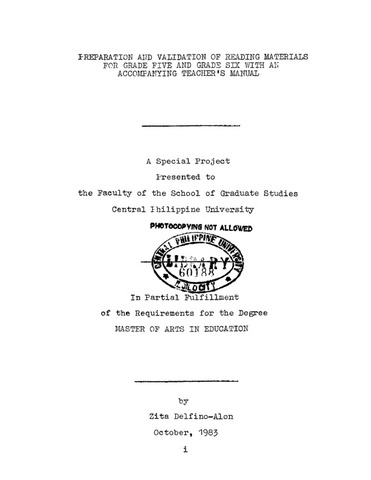| dc.contributor.author | Alon, Zita Delfino | |
| dc.date.accessioned | 2021-10-06T07:54:45Z | |
| dc.date.available | 2021-10-06T07:54:45Z | |
| dc.date.issued | 1983 | |
| dc.identifier.citation | Alon, Z. D. (1983). Preparation and validation of reading materials for grade five and grade six with an accompanying teacher's manual (Unpublished Master’s special paper). Central Philippine University, Jaro, Iloilo City. | en_US |
| dc.identifier.uri | https://hdl.handle.net/20.500.12852/1489 | |
| dc.description | Introduction and statement of the problem | en_US |
| dc.description.abstract | The Importance of Reading Skills; The Teacher's Role
Reading is a complex developmental process that involves not only the various skills of word recognition and comprehension hut also the whole personality of the reader. A child learning to read must learn equally to recognize written symbols and to get moaning from the printed page. Word recognition and comprehension skills themselves entail other related subskills, the proficient use of which helps the child become a better reader. In addition, the child should have a positive attitude towards the reading task if he is to profit from instruction on how to read.
The love for books and reading begins at home before the child is able to read. A child who is exposed to wholesome varied reading materials at home and sees his parents and/or other members of the family read soon picks up the habit and thus has a greater chance of achieving more in reading than the one who is not so privileged.
At no other time has the teaching of reading become more challenging to teachers than today when reading has to compete with the radio, the television, the ovies, and other means of communication. These drive prospective readers away from hooks; consequently, they lose their interest in reading. Bond and Wagner point out this fact thus;
“....Another causal factor in the low level of reading interest and tastes is the competition for leisure time activity between reading and listening to the radio, attending to television, seeing a motion picture and other leisure time activities... Unless reading is made worthwhile, these media will usurp the child's- entire leisure time...”
What then can a reading teacher do for today's children who have diverse interests and abilities being appealed to by competing non-print media?
In the classroom, the teacher is still considered the most influential factor that cannot be replaced by even the most modern of teaching gadgets. It is, therefore, within her power to make reading a satisfying, worthwhile, and enjoyable experience. She can do this by utilizing the above-mentioned "hardware," referred to by Bond and Wagner in the preceding quotation, in her instruction if she can avail herself of their use. Otherwise, a creative and imaginative teacher can think of or devise a thousand and one ways, other than those media, in teaching reading effectively.
It is also imperative that teachers provide their pupils with varied interesting reading materials that are within their reading levels and experiential backgrounds. By so doing, they extend their pupils' reading interests and improve the quality of their reading tastes. They will also foster favorable attitudes towards reading among the children and, ultimately, enhance their reading skills.
The teacher's role, then, is to make reading attractive enough to be worth the effort to learn it.
It is with this possibility in mind that the writer prepared reading materials which approximate the above criteria. She hopes that these materials can help improve the quality of reading instruction in Region VI and consequently improve pupil achievement in reading.
Statement of the Problem
This study was an attempt to produce interesting reading materials that are within the grade levels of pupils in Region VI. Answers to the following questions were sought:
1. What kind of stories are interesting to inter mediate grade pupils?
2. What factors influence the readability of a material?
3. How can the grade level of a reading material be determined?
4. How reliable are the exercises developed to test comprehension of the reading selections? | en_US |
| dc.description.sponsorship | Ministry of Education, Culture and Sports, Region VI scholarship grant | en_US |
| dc.format.extent | 208 leaves | en_US |
| dc.language.iso | en | en_US |
| dc.subject.ddc | GSL Theses 378.242 Al725 | en_US |
| dc.subject.lcsh | Reading (Elementary)--Handbooks, manuals, etc | en_US |
| dc.subject.lcsh | Teachers' guides | en_US |
| dc.subject.lcsh | Reading--Aids and devices | en_US |
| dc.subject.lcsh | Reading--Aids and devices--Evaluation | en_US |
| dc.subject.lcsh | Reading (Elementary) | en_US |
| dc.subject.lcsh | Reading (Elementary)--Ability testing | en_US |
| dc.subject.lcsh | Teachers--Handbooks, manuals, etc. | en_US |
| dc.subject.lcsh | Reading interests | en_US |
| dc.title | Preparation and validation of reading materials for grade five and grade six with an accompanying teacher's manual | en_US |
| dc.title.alternative | Preparation and validation of reading materials for grade 5 and grade 6 with an accompanying teacher's manual | en_US |
| dc.type | Special paper | en_US |
| dc.description.bibliographicalreferences | Includes bibliographical references | en_US |
| dc.contributor.chair | Herradura, Elma S. | |
| dc.contributor.committeemember | Cang, Febe A. | |
| dc.contributor.committeemember | Ruiz, Macario B. | |
| dc.contributor.committeemember | Griño, Eliza U. | |
| dc.contributor.committeemember | Traviña, Miriam M. | |
| dc.contributor.department | School of Graduate Studies | en_US |
| dc.description.degree | Master of Arts in Education with specialization in Reading (English) | en_US |
| local.relation.associatedcontent | https://repository.cpu.edu.ph/handle/20.500.12852/2646 Journal article published in Southeast Asia Journal | en |


